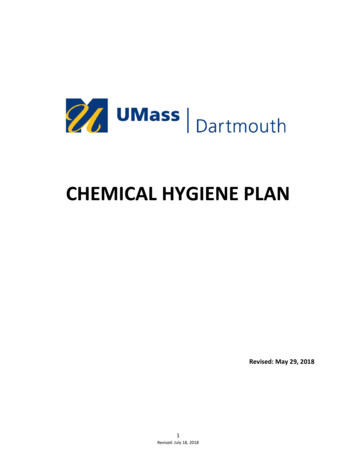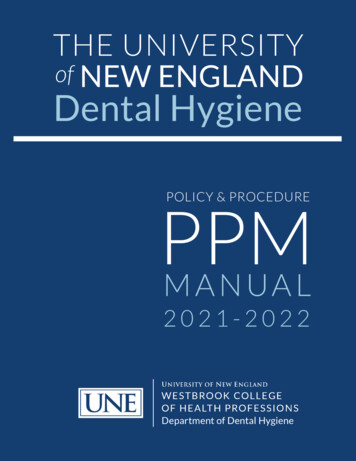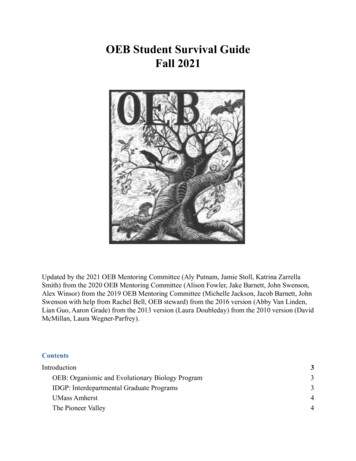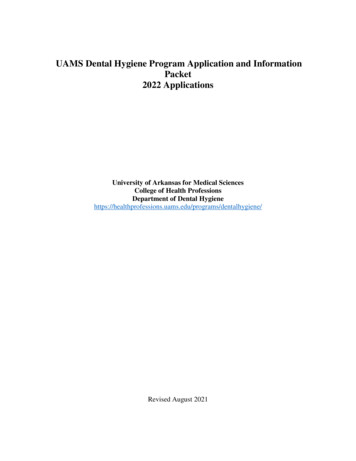
Transcription
CHEMICAL HYGIENE PLANRevised: May 29, 20181Revised: July 18, 2018
Table of ContentsCHP Document Abbreviations List . 4Introduction . 51.1. Purpose . 51.2. Scope . 51.3. CHP Use Instructions . 61.4. Employee Rights and Responsibilities. 71.4.1.Laboratory Supervisor Responsibilities . 71.4.2.Laboratory Employee Responsibilities . 81.4.3.Laboratory Safety Officer Responsibilities . 81.4.4.Non-Laboratory Personnel / Support Staff Responsibilities . 91.4.5.Director of EH&S Responsibilities . 91.5. Environmental Health and Safety Department . 10Hazardous Chemical Classification Systems . 112.1 Globally Harmonized System for Classifying Chemicals . 112.2 National Fire Protection Association Rating System. 152.3 Department of Transportation Hazard Classes . 16Classes of Hazardous Chemicals . 183.1 Physical Hazards . 183.2 Health Hazards . 193.3 Biological Hazards . 203.4 Radioactive Material Hazards . 203.5 Laser Hazards . 20Laboratory Safety Controls . 214.1 Routes of Exposure . 214.2 Engineering Controls and Safety Equipment . 214.3 Administrative Controls . 254.4 Personal Protective Equipment (PPE) . 26Laboratory Management Plan . 285.1 Laboratory Safety Guidelines . 285.2 Housekeeping . 305.3 Chemical Inventories . 315.4 Safety Data Sheets . 315.5 Chemical Labeling Requirements. 315.6 Chemical Segregation . 315.7 Chemical Procurement . 335.8 Chemical Storage Requirements. 335.8 Compressed Gas Cylinder Safety . 385.9 Sharps Handling Safety . 395.10 Equipment, Apparatus, and Instrument Safety . 405.11 Research Samples and Chemicals Developed in the Lab . 445.12 Transporting Hazardous Chemicals . 455.13 Laboratory Security . 475.14 Laboratory Self-Inspections . 485.15 Laboratory Ergonomics . 482Revised: July 18, 2018
5.16 Laboratory Electrical Safety . 49Laboratory PPE Policy. 526.1 Purpose . 526.2 Scope . 526.3 Hazard Assessment . 526.4 Minimum PPE Requirements for Laboratories . 546.5 Minimum PPE Requirements for Support Staff and Visitors . 576.6 PPE Training Requirements . 576.7 Injuries, Illnesses, and Medical Examinations. 58Hazardous Waste Management. 597.1 Introduction . 597.2 Waste Identification and Labeling . 607.3 Waste Storage Requirements . 617.4 Waste Containers . 627.5 Waste Disposal Procedures . 637.6 Unknown Chemical Waste . 637.7 Sink and Trash Disposal. 657.8 Sharps Waste . 657.9 Liquid Chromatography Waste . 658.1 Non-Emergency Chemical Spill Procedures . 678.2 Emergency Chemical Spill Procedures . 678.3 Chemical Spill Kits . 689.1 CHP Training . 699.2 PPE Training . 709.3 SOP Training . 70Appendix A Lab-Specific Awareness Certification Form . 71Appendix B OSHA Hazard Class Definitions . 73Appendix C Peroxide Forming Chemicals . 81Appendix D Chemical Resistance Guide - Gloves . 84Appendix E Cryogens and Dry Ice Safety Fact Sheet . 85Appendix F Fume Hood Safety Fact Sheet . 86Appendix G Peroxide Classifications . 87Appendix H Segregation Classification of Chemicals . 88Appendix I Waste Types . 89Tab 1 Lab-Specific Standard Operating Procedures . 90Tab 2 Lab-Specific Protocols, Requirements, Rules . 91Tab 3 Lab-Specific Hazard Assessments . 923Revised: July 18, 2018
CHP Document Abbreviations rDNARSCSAASDSSOPUELAmerican National Standards InstituteAmerican Society of Testing and MaterialsCode of Federal RegulationsChemical Hygiene OfficerChemical Hygiene PlanChemical and Laboratory Safety CommitteeDepartment of TransportationEnvironmental Health and SafetyEnvironmental Protection AgencyGround Fault Circuit InterrupterGlobally Harmonized System of Classification and Labeling of ChemicalsHydrogen BromideHydrofluoric AcidHigh-Efficiency Particulate AirHigh Performance Liquid ChromatographyInstitutional Biosafety CommitteeIntegrated Safety PlanLiquid ChromatographyLethal Concentration 50%Lethal Dose 50%Lower Explosive LimitLaser Safety CommitteeNational Fire Protection AssociationOccupational Safety and Health AdministrationPolychlorinated BiphenylParticularly Hazardous SubstancePrincipal InvestigatorPersonal Protective EquipmentResource Conservation and Recovery ActRecombinant Deoxyribonucleic AcidRadiation Safety CommitteeSatellite Accumulation AreaSafety Data SheetStandard Operating ProcedureUpper Explosive limit4Revised: July 18, 2018
Chapter 1: IntroductionIntroductionLaboratory safety is an integral part of laboratory research and is essential to ensure that theUniversity of Massachusetts – Dartmouth (UMass Dartmouth) is compliant with all applicableenvironmental, health and safety laws, regulations. The risks associated with laboratoryresearch (workplace injuries, environmental incidents, and property losses or damage) aregreatly reduced or eliminated when proper precautions and practices are observed in thelaboratory. To better manage and mitigate these risks, the UMass Dartmouth EnvironmentalHealth and Safety Department (EH&S) has developed the Chemical Hygiene Plan (CHP), which isintended to be the cornerstone of your laboratory safety program and is designed to aidfaculty, staff, and students in maintaining a safe environment in which to teach and conductresearch. Each laboratory using hazardous materials is required to have a copy of the CHPreadily available to all laboratory personnel. Each laboratory worker must be familiar with thecontents of the CHP and the procedures for obtaining additional safety information needed toperform their duties safely.1.1.PurposeUMass Dartmouth has developed the CHP to explain the policies and procedures that willpromote the safe operation of the University’s teaching and research laboratories. In addition,the CHP satisfies the requirements of the U.S. Department of Labor, Occupational Safety andHealth Administration, 29 CFR Part 1910.1450, Occupational Exposures to Hazardous Chemicalsin Laboratories. This regulation is known as the “Laboratory Standard”; the objective of the“Laboratory Standard” is to protect employees from the physical and health hazards associatedwith hazardous chemicals in the laboratory.1.2.ScopeThe CHP applies to all laboratories that use, store, or handle hazardous chemicals and allpersonnel who work in these facilities. The information presented in the CHP represents bestpractices and provides a broad overview of the information necessary for the safe operation oflaboratories that utilize hazardous chemicals. Laboratory use of hazardous chemicals is definedas handling or use of such chemicals in which all of the following conditions are met: Chemical manipulations are carried out on a laboratory scale;Multiple chemical procedures or chemicals are used;The procedures involved are not part of a production process, nor in any waysimulate a production process; andProtective laboratory practices and equipment are made available and in commonuse to minimize the potential for employee exposure to hazardous chemicals.5Revised: July 18, 2018
Chapter 1: IntroductionThe CHP was prepared in accordance with the requirements of the Occupational Safety andHealth Administration (OSHA) Occupational Exposure to Hazardous Chemicals in LaboratoriesStandard (Lab Standard) found in 29 CFR 1910.1450, and is based on best practices identified in,among other sources, the “Global Harmonized System of Classification and Labeling ofChemicals”; “Prudent Practices for Handling Hazardous Chemicals in Laboratories”, publishedby the National Research Council, the American Chemistry Society Task Force on LaboratoryChemical and Waste Management’s “Laboratory Waste Management, A Guidebook”; and thePrinceton University “Laboratory Safety Manual”.1.3.CHP Use InstructionsThe information presented in the CHP represents best practices and provides a broad overviewof the information necessary for the safe operation of laboratories that utilize hazardouschemicals. It is not intended to be all inclusive. Departments engaged in work with hazardouschemicals or hazardous operations that are not sufficiently covered by the CHP must customizethis document by adding appropriate sections, in the form of standard operating procedures(SOPs), hazard assessments, and any other written (or referenced) lab-specific operatingprocedures or protocols that address the hazards and how to mitigate risks. The followinginstructions detail how this CHP template should be used and customized by each laboratory: Review this CHP provided by EH&S. Insert your lab-specific SOPs into your customized CHP under Tab 1 located in theback of the CHP document. More details regarding SOPs can be found in Chapter 4 ofthe CHP. Insert all other documented lab-specific rules, requirements, and procedures (e.g.,equipment protocols, chemical experiment protocols, internal lab inspections orrules, etc.,) under Tab 2. Insert your lab-specific hazard assessments under Tab 3. More details regardinghazard assessments can be found in Chapter 6 of the CHP. Once each lab employee has reviewed and is familiar with the contents of the labspecific CHP, document the training using the CHP Awareness Certification Formfound in Appendix A of the CHP. See Chapter 9 for additional detail regarding CHPtraining. Review, update (if necessary), and retrain all employees on the lab-specific CHP atleast annually and document this training. 6Revised: July 18, 2018
Chapter 1: Introduction1.4.Employee Rights and ResponsibilitiesAs part of the OSHA Laboratory Standard, employees and other personnel who work inlaboratories have the right to be informed about the potential hazards of the chemicals in theirwork areas and to be properly trained to work safely with these substances. This includescustodial and maintenance personnel (support staff) who work to maintain laboratories. Allpersonnel, including principal investigators, laboratory supervisors, laboratory technicians,student workers, and support staff have a responsibility to maintain a safe work environment. Allpersonnel working with chemicals are responsible for staying informed on the chemicals in theirwork areas, safe work practices and SOPs, and proper personal protective equipment (PPE)required for the safe performance of their laboratory work.1.4.1. Laboratory Supervisor ResponsibilitiesThe Laboratory Supervisor is the individual that is ultimately responsible for the overalllaboratory operation, including the lab safety program and ensuring that the requirementsof the CHP are followed by all staff members that work in the lab. For most researchlaboratories, the Principal Investigator (PI) is the Laboratory Supervisor. In cases where thePI has hired an individual such as a lab manager or postdoctoral scholar to manage the dailyoperations of the lab, the PI is still ultimately responsible for the overall operation of the laband is considered to be the Laboratory Supervisor. The Laboratory Supervisor may delegatesome safety duties to a qualified individual, but ultimately remains responsible for thesafety of all personnel working in the laboratory. Specifically, the Laboratory Supervisormust: Understand applicable environmental health and safety rules, including the contentsof the CHP;Identify hazardous conditions or operations in the laboratory and establish SOPs andhazard assessments to effectively control or reduce hazards;Ensure that all laboratory personnel that work with hazardous chemicals receiveappropriate training (refer to Chapter 9 for detailed training requirements);Maintain written records of lab-specific training (e.g., PPE training);Ensure that appropriate PPE (e.g., laboratory coats, gloves, eye protection, etc.,) andengineering control equipment (e.g., chemical fume hood) are made available, ingood working order, and being used properly;Conduct periodic lab inspections and immediately take steps to abate hazards thatmay pose a risk to life or safety upon discovery of such hazards; and7Revised: July 18, 2018
Chapter 1: Introduction Actively enforce all applicable safety procedures and ensure that the CHP is followedby lab staff and all visitors, including having a progressive disciplinary process for labstaff members that do not comply with safety rules.Laboratory Supervisors must ensure that employees receive CHP training and informationbefore any work with hazardous materials occurs. Laboratory Supervisors must also ensurethat all employees receive annual CHP refresher training. The Laboratory Supervisor canprovide the training or delegate this task to a qualified individual (e.g., Laboratory SafetyOfficer, senior lab employee). The CHP training must be documented. See Appendix A forthe CHP Lab-Specific Awareness Certification form, which can be used to document readingthe CHP. Failure to follow the requirements of the CHP could possibly result in injuries, finesfrom regulatory agencies such as OSHA, and/or disciplinary action1.4.2. Laboratory Employee Responsibilities Review and follow the requirements of the CHP;Follow all verbal and written laboratory safety rules, regulations, and SOPs requiredfor the tasks assigned;Develop and practice good personal chemical hygiene habits such keeping work areasclean and uncluttered;Plan, review, and understand the hazards of materials and processes in the laboratoryprior to conducting work;Utilize appropriate measures to control hazards, including consistent and proper useof engineering controls, administrative controls, and PPE;Understand the capabilities and limitations of PPE;Immediately report all accidents, near misses, and unsafe conditions to theLaboratory Supervisor;Complete all required EH&S and/or other mandatory safety training and providewritten documentation to the Laboratory Supervisor;Inform the Laboratory Supervisor of any work modifications ordered by a physician asa result of medical surveillance, occupational injury, or chemical exposure.1.4.3. Laboratory Safety Officer ResponsibilitiesVery often it is not practical for the Laboratory Supervisor to be present in the lab on a dailybasis to ensure that safe and compliant practices are being carried out by all lab staff. Forthis reason, it is highly recommended that each Laboratory Supervisor establish aLaboratory Safety Officer to manage the daily operations of the lab’s safety program. TheLaboratory Supervisor should empower the Laboratory Safety Officer to make decisions ondaily operations involving safety and compliance, including the authority to instruct otherlab personnel to follow all safety procedures (e.g., PPE use, hazardous waste procedures,etc.). This person should be familiar with how the lab operates and have demonstrated lab8Revised: July 18, 2018
Chapter 1: Introductionsafety experience (e.g., senior graduate student, post-doc, lab manager). Having aLaboratory Safety Officer in the lab provides many benefits such as: Other lab personnel know who to contact with questions about daily operationsinvolving safety and compliance;Empowers someone other than the Laboratory Supervisor to enforce lab safetyrules;Provides consistency within the respective academic department; idea is that eachLaboratory Safety Officer attends departmental safety committee meetings andreports issues back to the lab; andProvides good, marketable experience for the Laboratory Safety Officer to beinvolved in a safety leadership role.The role of the Laboratory Safety Officer should include: Provide appropriate training to new lab personnel and ensure that the training isproperly documented;Enforce lab safety rules;Attend departmental/college level safety committee meetings and report significantinformation back to the lab; andReport safety issues back to the Laboratory Supervisor when necessary.1.4.4. Non-Laboratory Personnel / Support Staff ResponsibilitiesCustodians and maintenance staff (support staff) often must enter laboratories to performroutine tasks such as cleaning and equipment maintenance. Support staff members areexpected to follow the posted safety rules of each laboratory. Minimum PPE requirementsfor support staff working in a laboratory are safety glasses, long pants, and closed-toeshoes. If additional PPE is required or if other unique safety requirements must befollowed, it is the lab personnel’s responsibility to notify support staff. These additionalrequirements should be clearly communicated to support staff; posting the requirementson the lab door or somewhere else highly visible is recommended.1.4.5. Director of EH&S ResponsibilitiesThe Director of EH&S, or designated individual(s), has the primary responsibility forensuring the implementation of all components of the CHP. The Director of EH&S must: Inform Laboratory Supervisors of all health and safety requirements and assist withthe selection of appropriate safety controls (engineering controls, administrative9Revised: July 18, 2018
Chapter 1: Introduction 1.5.controls, and PPE);Ensure that Laboratory Supervisors have the necessary resources to maintaincompliance with the CHP and that all lab staff receive appropriate training;Conduct periodic lab inspections and immediately take steps to abate hazards thatmay pose a risk to life or safety upon discovery of such hazards;Ensure that SOPs and hazard assessments are being prepared;Help to develop and implement appropriate environmental health and safetypolicies and procedures;Review and evaluate the effectiveness of the CHP program at least annually andupdate it as appropriate; andActively enforce all applicable safety procedures and ensure the contents of the CHPare followed; take appropriate actions when safety procedures are not followed.Environmental Health and Safety DepartmentEH&S’s primary role is to manage regulatory compliance with all federal, state, local andUMass Dartmouth regulations involving environmental health and safety issues. EH&Sfacilitates a number of programs that apply to laboratory safety, a few of which includebiological safety, laser safety, personal protective equipment, radiation safety, development ofstandard operating procedures, as well as the CHP. EH&S also performs numerous safetyinspections of facilities throughout the year to monitor compliance with regulatoryrequirements. EH&S also provides a variety of services such as chemical, biological, andradioactive waste pickups, and safety training and consultation. More detailed informationregarding all of EH&S’s resources and services can be found on the UMass Dartmouth EH&Swebsite.10Revised: July 18, 2018
Chapter 2: Chemical Classification SystemsHazardous Chemical Classification SystemsChemical classification systems are designed to communicate hazards. The three most widelyused classification systems are the OSHA Globally Harmonized System for Classifying andLabeling Chemicals (implemented under the OSHA Hazard Communication Standard), theNational Fire Protection Association (NFPA) system of classifying the severity of hazards, andthe Department of Transportation (DOT) hazard classes. These classification systems are usedby chemical manufacturers when creating safety data sheets and chemical labels, therefore it isimportant that UMass Dartmouth lab employees understand the basic elements of eachclassification system.2.1Globally Harmonized System for Classifying ChemicalsThe Globally Harmonized System (GHS) is a world-wide system adopted by OSHA forstandardizing and harmonizing the classification and labeling of chemicals. The objectives of theGHS are to: Define health, physical, and environmental hazards of chemicals;Create classification processes that use available data on chemicals for comparison withthe defined hazard criteria (numerical hazard classification is based on a 1 – 5 scale, 1being the most hazardous and 5 being the least hazardous); andCommunicate hazard information, as well as protective measures, on labels and SafetyData Sheet (SDS), formerly known as Material Safety Data Sheets (MSDS).2.1.1 Safety Data SheetsThe SDS provides comprehensive information that is imperative for the safe handling ofhazardous chemicals. Laboratory personnel should use the SDS as a resource to obtaininformation about hazards and safety precautions. SDSs cannot provide information forhazards in all circumstances. However, the SDS information enables the employer todevelop an active program of worker protection measures such as training on hazardmitigation. Chemical manufacturers are required to use a standard format when developingSDSs. The SDS will contain 16 headings which are illustrated in Figure 2.1.11Revised: July 18, 2018
Chapter 2: Chemical Classification Systems1.Identification of the substance ormixture and of supplier9.Physical and chemical properties2.Hazards Identification10.Stability and reactivity3.Composition/information oningredients11.Toxicological information4.First aid measures12.Ecological information5.Firefighting measures13.Disposal considerations6.Accidental release measures14.Transport considerations7.Handling and storage15.Regulatory information8.Exposure controls/personalprotection16.Other informationFigure 2.1 – GHS Required Sections of a Safety Data Sheet2.1.2 Chemical LabelingThe GHS standardized label elements, which are not subject to variation and must appearon the chemical label, contain the following elements: Symbols (hazard pictograms) are used to convey health, physical and environmentalhazard information, assigned to a GHS hazard class and category;Signal Words such as “Danger" (for more severe hazards) or "Warning" (for lesssevere hazards), are used to emphasize hazards and indicate the relative level ofseverity of the hazard assigned to a GHS hazard class and category;Hazard statements (e.g., “Danger! Extremely Flammable Liquid and Vapor”) arestandard phrases assigned to a hazard class and category that describe the nature ofthe hazard; andPrecautionary statements are recommended measures that should be taken tominimize or prevent adverse effects resulting from exposure to the hazardouschemical.The GHS also standardizes the hazard pictograms that are to be used on all hazard labelsand SDSs. There are 9 pictograms that represent several defined hazards, and include theharmonized hazard symbols which are intended to convey specific information about eachhazard. Figure 2.2 illustrates these GHS hazard pictograms.12Revised: July 18, 2018
Chapter 2: Chemical Classification SystemsCarcinogen, RespiratoryFlammable, Pyrophoric, SelfSensitizer, ReproductiveHeating, Emits Flammable Gas,Toxicity, Target Organ Toxicity,Organic PeroxideMutagenicityIrritant, Dermal Sensitizer,Acute Toxicity (harmful),Narcotic EffectsGas Under PressureCorrosiveExplosive, Organic Peroxide,Self-ReactiveOxidizerEnvironmental ToxicityAcute Toxicity (Severe)Figure 2.2 – GHS Hazard PictogramsGHS labeling requirements are only applicable to chemical manufacturers, distributors, andshippers of ch
4 Revised: July 18, 2018 CHP Document Abbreviations List ANSI American National Standards Institute ASTM American Society of Testing and Materials CFR Code of Federal Regulations CHO Chemical Hygiene Officer CHP Chemical Hygiene Plan CLSC Chemical and Laboratory Safety Committee DOT Department of Transportation EH&S Environmental Health and Safety










